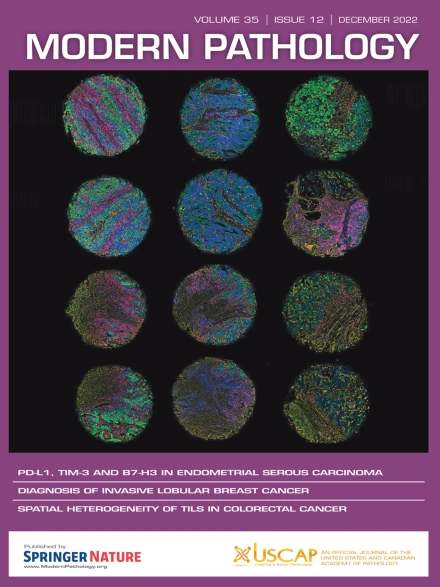11例极突变子宫癌肉瘤的临床病理及分子分析。
IF 7.1
1区 医学
Q1 PATHOLOGY
引用次数: 0
摘要
子宫癌肉瘤(UCS)是高级别双相肿瘤,通常预后较差。根据TCGA对子宫内膜癌的分子分类,大多数UCS被分类为拷贝数高/浆液样(p53异常);然而,一小部分代表其他分子亚型,包括那些携带POLE突变的分子亚型。我们在三个机构中鉴定了11例pole突变(POLEmut) UCS,并评估了这些肿瘤的临床、组织病理学、免疫组织化学和分子特征。POLEmut UCS发生于成年女性(中位年龄64岁,范围48 ~ 79岁),通常表现为FIGO(2009)临床分期IA (n= 4)或IB (n=3)。几乎所有肿瘤均以癌性为主(n= 10),多数表现为子宫内膜样形态(n= 7),其次为模糊组织型(n=4)和浆液组织型(n= 3)。免疫组化结果显示,7例肿瘤出现p53异常或亚克隆异常表达,其中6例肿瘤序列显示TP53致病性突变。其他常见突变包括PIK3CA(10/11)、PTEN(8/11)、RB1(7/11)、ARID1A(7/11)、ATM(6/11)、PIK3RA(5/11)和FBXW7(4/11)。两个肿瘤显示失配修复蛋白表达缺失,一个有亚克隆缺失。异源分化不常见,仅观察到软骨肉瘤型(n = 2)。平均随访时间为24.3个月,中位随访时间为14.1个月(1.4 ~ 61.1个月)。10例患者(91%)无复发或疾病死亡,其中3例有随访期本文章由计算机程序翻译,如有差异,请以英文原文为准。
POLE-Mutated Uterine Carcinosarcomas: A Clinicopathologic and Molecular Study of 11 Cases
Uterine carcinosarcomas (UCS) are high-grade biphasic neoplasms with generally poor outcomes. Based on The Cancer Genome Atlas molecular classification of endometrial carcinomas, the majority of UCS are classified as copy-number high/serous-like (p53-abnormal); however, a small subset represent other molecular subtypes, including those that harbor POLE mutations. We identified 11 POLE-mutated (POLEmut) UCS across 3 institutions and assessed the clinical, histopathologic, immunohistochemical, and molecular features of these tumors. POLEmut UCS occurred in adult women (median age, 64 years; range, 48-79 years) and usually presented as The International Federation of Gynecology and Obstetrics 2009 clinical stage IA (n = 4) or IB (n = 3). Almost all tumors were predominantly carcinomatous (n = 10), with most showing endometrioid morphology (n = 7), followed by ambiguous (n = 4) and serous (n = 3) histotypes. By immunohistochemistry, 7 tumors showed aberrant or subclonally aberrant expression of p53, 6 of which harbored pathogenic mutations in TP53 by sequencing. Other frequent mutations included PIK3CA (10/11), PTEN (8/11), RB1 (7/11), ARID1A (7/11), ATM (6/11), PIK3RA (5/11), and FBXW7 (4/11). Two tumors demonstrated loss of mismatch repair protein expression, and 1 had subclonal loss. Heterologous differentiation was uncommon, and only chondrosarcomatous type (n = 2) was observed. Mean and median follow-ups were 24.3 and 14.1 months, respectively (range, 1.4-61.1 months). Ten patients (91%) had no recurrences or death from disease, although 3 of these had follow-up periods <1 year. One patient, with the subclonal POLE variant, presented with stage IV disease and died 1.4 months after surgery. In conclusion, POLEmut UCS demonstrate unique morphologic and immunohistochemical features compared with their p53-abnormal counterparts and may have significant prognostic differences. Our study supports full molecular classification of UCS. We also raise awareness for potentially assessing POLE mutation allele frequency and clonality in consideration of classifying a tumor as POLEmut.
求助全文
通过发布文献求助,成功后即可免费获取论文全文。
去求助
来源期刊

Modern Pathology
医学-病理学
CiteScore
14.30
自引率
2.70%
发文量
174
审稿时长
18 days
期刊介绍:
Modern Pathology, an international journal under the ownership of The United States & Canadian Academy of Pathology (USCAP), serves as an authoritative platform for publishing top-tier clinical and translational research studies in pathology.
Original manuscripts are the primary focus of Modern Pathology, complemented by impactful editorials, reviews, and practice guidelines covering all facets of precision diagnostics in human pathology. The journal's scope includes advancements in molecular diagnostics and genomic classifications of diseases, breakthroughs in immune-oncology, computational science, applied bioinformatics, and digital pathology.
 求助内容:
求助内容: 应助结果提醒方式:
应助结果提醒方式:


